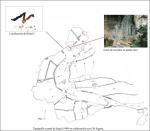Summary (English)
During an excursion to the Les Coves Ravine area schematic cave paintings were found by chance. After asking the General Directorate of Heritage for permission to act, we began work on the documentation and study using the application of new technologies for the digitalization of images that will serve as a support for later analysis of the representations.
Les Coves Ravine is located about 705 meters above sea level and it is framed geographically in the middle mountain zone of the Valencian central sector. From a geological viewpoint the site is in the morphostructural domain of cretacic mountain ranges and of northern neogenic valleys. Many of the characteristics of human settlement in the zone are determined by the orography and the weather conditions.
Shelter I is wide, with a length of 60 meters and depth of 10 meters, and is located on the right side of the ravine. It consists of only one concave cavity protected by a strong cap. The walls of the deepest zones and the roof of the shelter are covered by thick layers of soot. The remains of an enclosure made of dry stone abutting the shelter wall indicate its use as a farmyard in transhumance activities.
The rock paintings documented in Shelter I are the main decorated set. The poor state of conservation makes their reading complicated but there is only one composition of three motives. All of them present a technical uniformity, with the application of a dense textured pigment and an intense red colour and the recourse of flat ink. This uniformity at the technical level and its motley placing at the space suggest that it was only done once.
The height of this single set compared to the current ground level would be in line with the upright stance of the artist who would hardly need to modify his posture to complete the composition. The subjects depicted are the usual ones in scene sets with schematic motives.
Although the number of subjects depicted might indicate a minor decorative space, the scattered remains of pigment point to a notable compositional complexity which has been diminished by problems of conservation.
These new representations from the Les Cove Ravine add to the inventory of the Neolithic schematic rock paintings from the province of Alicante. These new paintings are part of an artistic context that stands out for its wealth, number and the entity of the decorated shelters where schematic, macroschematic and Levantine representations coexist. These decorated shelters reflect definitively the process of symbolic territorial occupation within the dynamic of Neolithic settlement in the Iberian Peninsula.
(translation by Pilar Alarcón Blázquez)
- Esther López Montalvo y Carles Miret Estruch
Director
- Esther López Montalvo y Carles Miret Estruch
Team
Research Body
- Colegio Oficial de Doctores y Licenciados en Filosofía y Letras y en Ciencias de Alicante - Sección de Arqueología
- Universidad de Valencia
Funding Body
- Universidad de Valencia






![Download [PDF]](/excavation/skins/fasti/images/results/download_sml.png)


